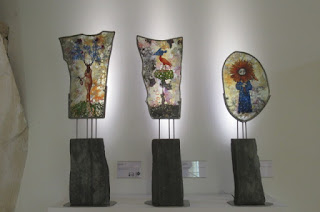Stained Glass

I had been seeing so much "stained glass" in churches and cathedrals, that I was very pleased to learn there was a Musée du Vitrail (Museum of Stained Glass -- "vitraux" are stained glass, plural, as in stained glass windows) in the Poitou region town of Cuzay-sur-Vonne, a whisper of a village in the western part of the Vienne department. Two aspects of the museum particularly interested me: 1) the display of contemporary colored glass, in addition to descriptions of how it's made (both blown and flat), and its history, particularly in religious settings; and 2) an on-site, resident artisan who showed me step-by-step how a stained glass window is made. My idea of a great time: indulging my senses while learning. Photos and explanation follow. First, some of the contemporary work exhibited: This plaque explains that the piece below, "Marie de Médicis" is by the artist who won the (2015, I think?) nationa...

